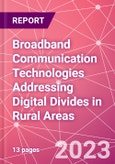This product will be delivered within 3-5 business days.
Table of Contents
1 . Bridging the Digital Divide through Broadband Infrastreucture Development
1.1 Insufficient Broadband Infrastructure as a Pending Issue
1.1.1 Provision of Funds for Broadband Infrastructure to Encourage Development in Underserved Areas
1.1.2 Provision of Subsidies for Communication Fees to Promote Broadband Usage among Low-Income Families
1.1.3 Provision of Free or Affordable Wi-Fi Services in Public Areas
1.1.4 Enhancement of Digital Proficiency through Digital Literacy Courses
2. Selecting Promising Broadband Communication Technologies for Rural Deployment
2.1 Geographic Environment and Economic Constraints as Major Barriers
2.2 Development of Rural Broadband Communication Technologies
2.2.1 Fiber Network
2.2.2 5G FWA (Fixed Wireless Access)
2.2.3 TVWS (TV White Space)
2.2.4 FSOC (Free-Space Optical Communication)
2.2.5 LEO (Low Earth Orbit)
2.3 Broadband Communication Technologies for Various Rural Settings
2.3.1 Comparison of Broadband Communication Technologies
2.3.2 Selection of Rural Broadband Communication Technologies
Publisher Perspective
Appendix
List of Companies
List of Tables
Table 1: Pros and Cons of Various Broadband Communication Technologies
Table 2 Comparison of Broadband Communication Technologies
List of Figures
Figure 1: Vulnerability of Different Countries' Economic Conditions and the Proportion with Internet Access, 2020
Companies Mentioned (Partial List)
A selection of companies mentioned in this report includes, but is not limited to:
- Gallup
- Moonshot
- Starlink
Methodology
Primary research with a holistic, cross-domain approach
The exhaustive primary research methods are central to the value that the analyst delivers. A combination of questionnaires and on-site visits to the major manufacturers provides a first view of the latest data and trends. Information is subsequently validated by interviews with the manufacturers' suppliers and customers, covering a holistic industry value chain. This process is backed up by a cross-domain team-based approach, creating an interlaced network across numerous interrelated components and system-level devices to ensure statistical integrity and provide in-depth insight.
Complementing primary research is a running database and secondary research of industry and market information. Dedicated research into the macro-environmental trends shaping the ICT industry also allows the analyst to forecast future development trends and generate foresight perspectives. With more than 20 years of experience and endeavors in research, the methods and methodologies include:
Method
- Component supplier interviews
- System supplier interviews
- User interviews
- Channel interviews
- IPO interviews
- Focus groups
- Consumer surveys
- Production databases
- Financial data
- Custom databases
Methodology
- Technology forecasting and assessment
- Product assessment and selection
- Product life cycles
- Added value analysis
- Market trends
- Scenario analysis
- Competitor analysis

LOADING...








